Best Dumbbell Exercises for Muscle Gain, Plus 3 Workouts
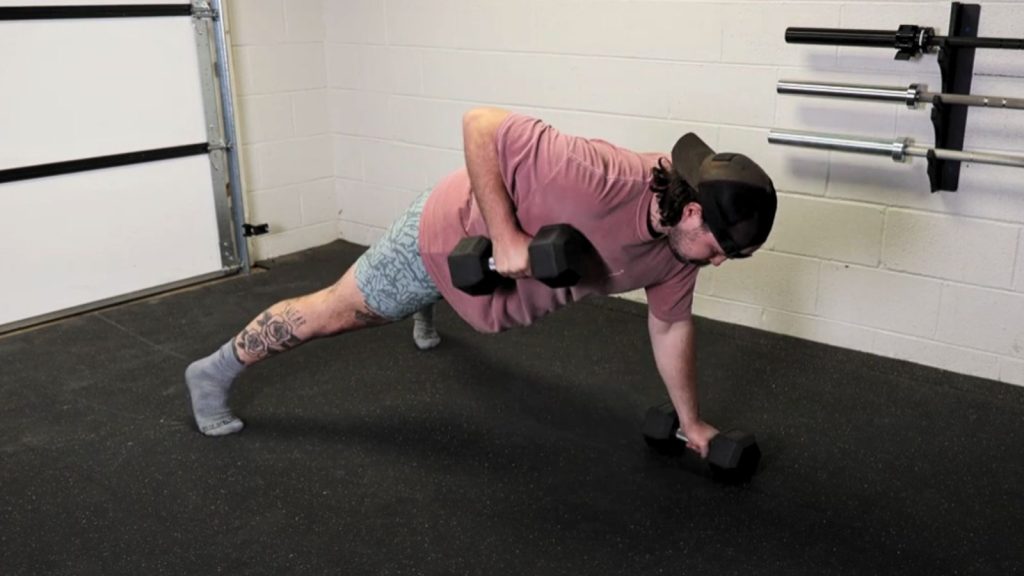
At BarBend, we review a lot of exercise equipment. Weekly we ask ourselves, what’s the best barbell out there? What are the best kettlebells for beginners? Is there a best treadmill, and if so, why?
Yet we often find ourselves turning back to the humble dumbbell. Dumbbell exercises aren’t just for beginners; upper-body dumbbell exercises can help you build muscle even after years of gym experience, and you can certainly gain strength by using dumbbells as well.
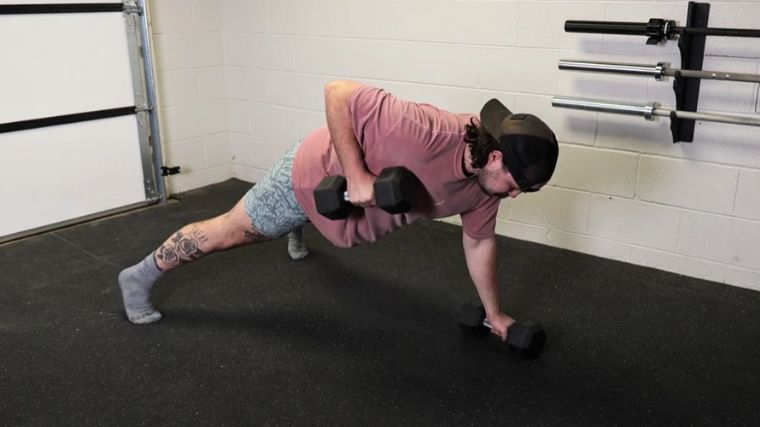
We really can’t speak highly enough about them, but what we can do is offer you 14 of our favorite dumbbell exercises for muscle gain and strength development:
14 Best Dumbbell Exercises
Recent Updates: This article was originally written by Jake Dickson, BarBend’s Senior Writer. Dickson revisited the list on Mar. 1, 2024, to review and update the movements so they better reflect BarBend’s contemporary best practices regarding exercise prescriptions. Read more about that process here.
1. Dumbbell Bench Press
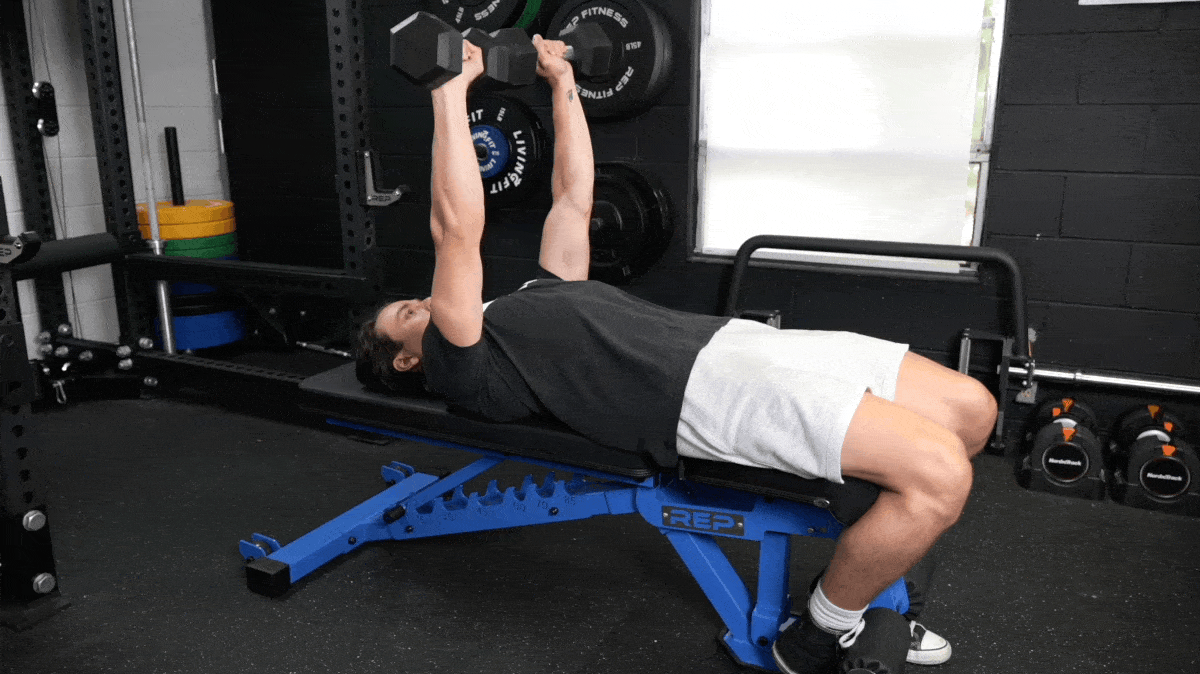
[Read More: How to Do a Dumbbell Bench Press, With Expert Tips & Video Guide]
| Equipment Needed | Dumbbells, weight bench, wrist wraps (optional) |
| Muscles Worked | Chest, shoulders, triceps |
| Sets & Reps | 3 x 6-8 |
If the standard push-up is a bit too easy for you, you might need to look beyond calisthenics for building up your chest. Any variation of a chest press will work just fine, but dumbbells specifically offer a few unique benefits to chest growth (and strengthening) that you can’t get from a barbell or a plate-loaded machine.
How To Do It
- Sit on the end of a weight bench with the dumbbells resting on your knees.
- Brace your core and lean backward onto the bench, simultaneously straightening your arms as you settle into the starting position.
- Lower the dumbbells slowly down until they graze your chest and then return them to arm’s length.
Modifications
- Make It Easier: You can do this movement on the floor as a way of limiting your range of motion, or tuck your upper arms to your sides to reduce shoulder discomfort.
- Make It Harder: Try holding your feet up in the air while you bench to give your core a workout.
2. Dumbbell Row
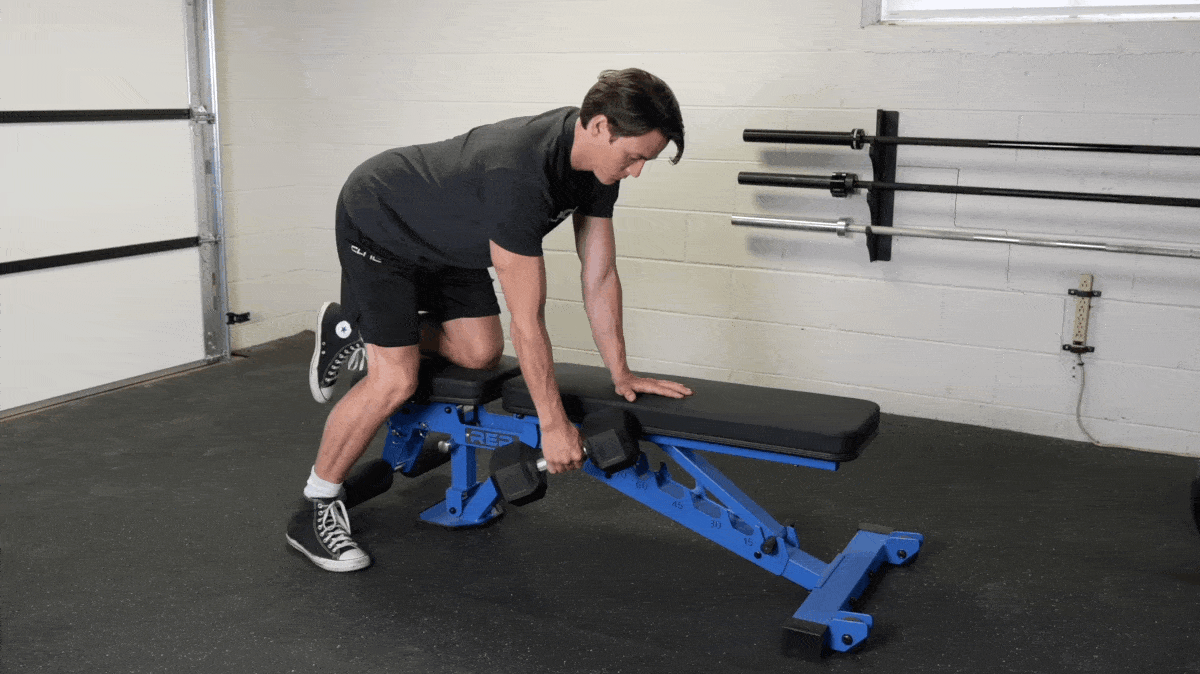
[Read More: The Best Biceps Exercises for Your Next Workout, Plus Expert Tips]
| Equipment Needed | Dumbbells, adjustable weight bench, lifting straps (optional) |
| Muscles Worked | Lats, traps, biceps, forearms |
| Sets & Reps | 3 x 8-12 |
It may be hard to see your back without the assistance of a mirror, but, thankfully, a pair of dumbbells can help you build it just fine. The dumbbell row (and its many, many variations) is a staple back exercise.
Making dumbbells your weapon of choice is wise as well — something pro physique athletes and strength enthusiasts alike are aware of.
How To Do It
- Support your torso with your non-working arm and the corresponding knee on a bench.
- Grab the dumbbell and row it by pulling your elbow up and back towards the crease of your hip.
Modifications
- Make It Easier: If you have an adjustable bench, set it to a medium incline and rest on your elbow to support your weight.
- Make It Harder: Try doing rows without using a bench at all, hinging over and keeping your torso steady just by bracing your abs.
3. Dumbbell Shrug

[Read More: The Best Forearm Exercises for Strength, Plus 4 Workouts]
| Equipment Needed | Dumbbells, lifting straps (optional) |
| Muscles Worked | Traps, forearms |
| Sets & Reps | 2-3 x 12-15 |
There’s really only one reliable way to beef up your traps or neck, and that’s the shrug. Simply elevating and depressing your shoulders is an easy enough motion to learn, the real question involves what equipment you should turn to to get the job done. We like dumbbells because they let you work each of your trap muscles independently.
How To Do It
- Stand upright with a pair of dumbbells in each hand.
- Lean slightly forward.
- Strongly contract your traps by elevating your shoulders up to your ears, holding for a moment, and then lowering them back down.
Modifications
- Make It Easier: You can perform shrugs sitting down instead of standing if needed.
- Make It Harder: Ditch the lifting straps and hold the weights with a thumbless grip to test your forearm strength.
4. Dumbbell Pullover
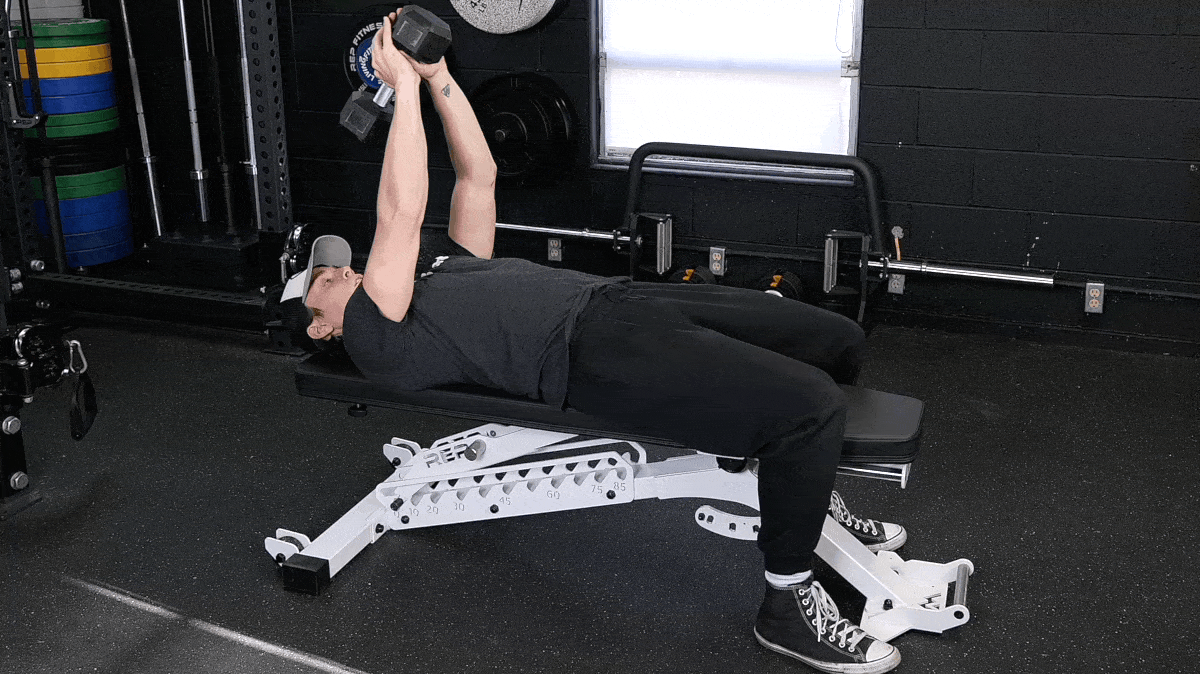
| Equipment Needed | Weight bench, dumbbell |
| Muscles Worked | Lats, triceps, chest |
| Sets & Reps | 2 x 15 |
There are a few exercises out there that are just a bit too useful. If you find a movement that works multiple opposing muscles at once — such as the pullover — you should stick with it, if not just for efficiency’s sake. Luckily, the dumbbell is the perfect tool for performing (and perfecting) the pullover.
How To Do It
- Lie on your back on a bench with your arms above you, hands clasping the plate of a dumbbell.
- Slowly lower it back behind your head until your arms are roughly parallel with your torso.
- Return the dumbbell to directly above your head.
Modifications
- Make It Easier: Do these on the floor instead of on a bench to limit your range of motion if you don’t have flexible shoulders.
- Make It Harder: Pause in the bottom of each rep with the weight behind your head.
5. Dumbbell Romanian Deadlift
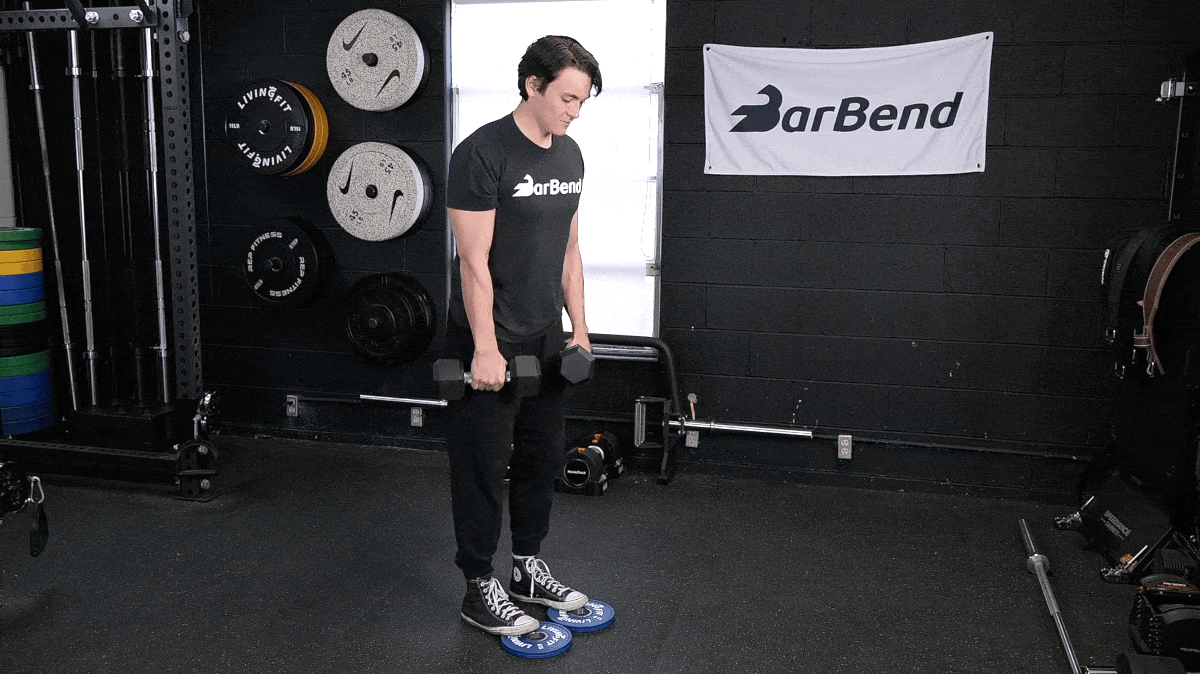
| Equipment Needed | Dumbbells, lifting straps (optional) |
| Muscles Worked | Hamstrings, glutes, lower back |
| Sets & Reps | 3 x 6-10 |
The hinge is one of your most foundational and essential movement patterns. You perform it on a daily basis whether you know it or not — bending over to pick up a child, or lift a crate, or even sinking into a respectful bow.
Training the hinge with the dumbbell Romanian deadlift also helps you develop your hamstrings, calves, lower back, and glutes. Dumbbells are a fantastic choice if you want to make the Romanian deadlift part of your workout routine.
How To Do It
- Stand with a pair of dumbbells in your hands and your weight slightly shifted into your heels.
- From here, break at the hips and shoot your butt backward.
- Allow the dumbbells to fall down your thigh until your torso is roughly parallel to the floor.
- Reverse the motion, squeezing your backside to stand back up.
Modifications
- Make It Easier: Standing with your shins up against the side of a bench can help you learn to push your hips back rather than doing a squat.
- Make It Harder: Try the B-stance dumbbell RDL, using one leg as a support kickstand and shifting the majority of your weight to the other leg.
6. Dumbbell Flye
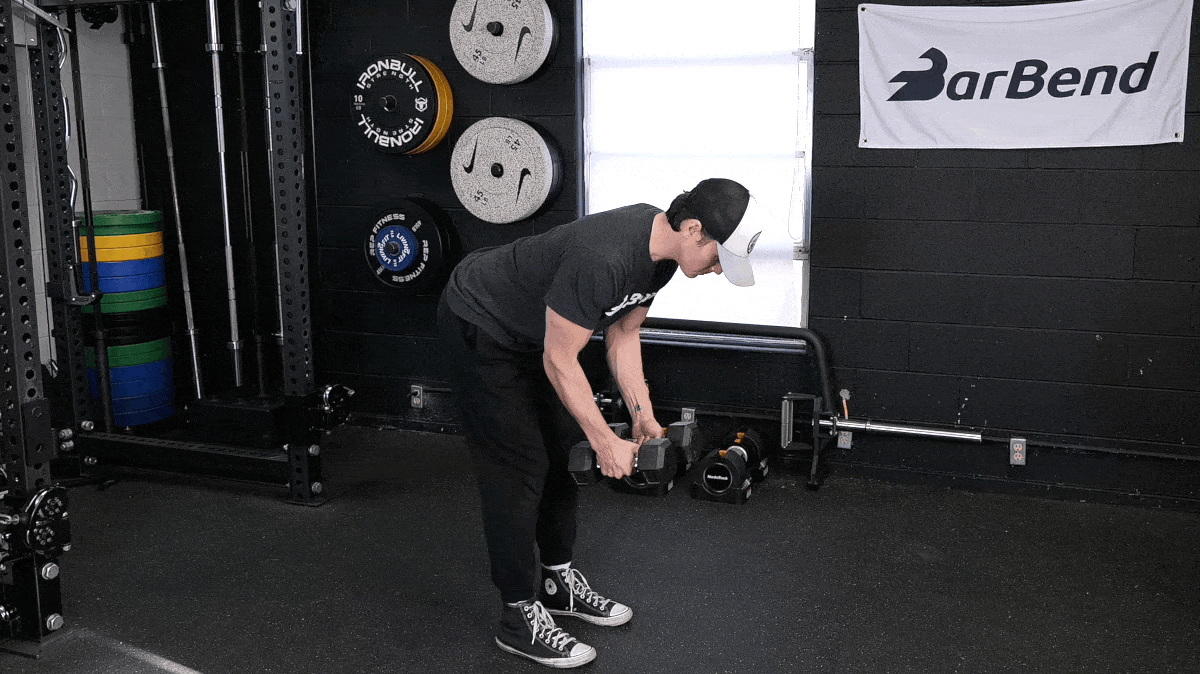
| Equipment Needed | Dumbbells, weight bench |
| Muscles Worked | Chest |
| Sets & Reps | 3 x 15 |
You don’t have to be enamored by heavy pressing to successfully add muscle to your chest. Your pecs’ other main anatomical function is humeral adduction, which is fancy phrasing for bringing your arm in toward your torso.
How To Do It
- Lie on your back on a bench with a dumbbell in each hand, arms straight above you.
- Open your arms slowly, palms to the ceiling, while keeping your elbows mostly straight.
- Drop your arms out to the side until they’re roughly parallel to the floor.
7. Dumbbell Lunge
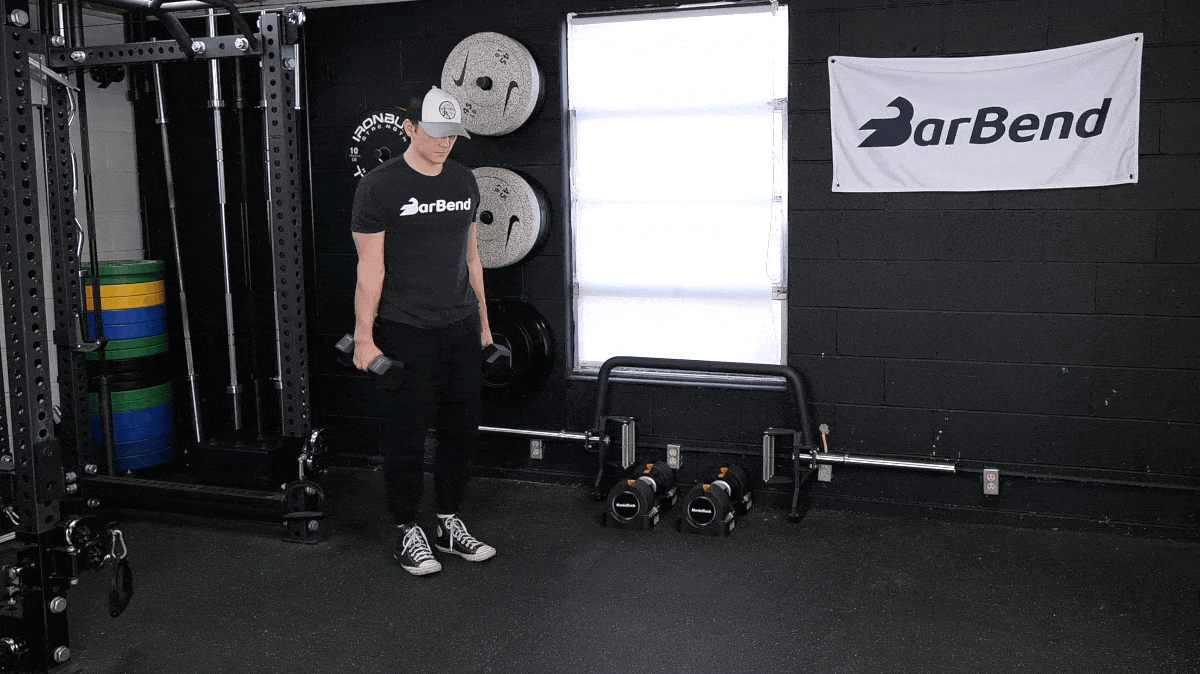
| Equipment Needed | Dumbbells, lifting straps (optional) |
| Muscles Worked | Quads, glutes, core |
| Sets & Reps | 2-3 x 10-15 |
Squats are all well and good, but you can walk your way to strong, shapely, and powerful legs with lunges.
By putting one foot in front of the other, literally, and loading yourself up with a pair of dumbbells, you can stimulate almost every muscle in your lower body at once and train your balance to boot.
How To Do It
- With a dumbbell in each hand, take a broad step outward in front of you and bend your knees to sink into a high split squat position.
- From here, push into the floor with your forward leg, and bring your back leg forward.
- Then, do the same motion with the opposing leg.
Modifications
- Make It Easier: Stand next to a horizontal rail and gently clasp it with one arm to assist your balance.
- Make It Harder: Try deficit lunges, stepping forward onto a low elevated surface like a bumper plate or riser.
8. Dumbbell Hammer Curl

| Equipment Needed | Dumbbells |
| Muscles Worked | Brachialis, biceps, forearms |
| Sets & Reps | 3 x 8-12 |
Dumbbells are the tried-and-true default tool for arm growth in most gyms, and for good reason. You can work your biceps independently to even out imbalances and prioritize the strongest contraction possible.
[Read More: Hammer Curls Vs. Biceps Curls — Which is Better for Building Bigger Arms?]
When it comes to building the brachialis, which lies underneath your biceps proper, your first and only stop should be the dumbbell hammer curl.
How To Do It
- Stand upright with a pair of dumbbells in your hands and your arms tucked to your sides.
- With control, bend your elbow and curl the weights upward, keeping your wrists in a neutral position, palms facing inward.
Modifications
- Make It Easier: You can perform this dumbbell biceps workout sitting down if necessary.
- Make It Harder: Stand with your back up against a wall and keep your elbows in contact with the wall at all times to prevent swaying or momentum.
. Dumbbell Skull Crusher

| Equipment Needed | Dumbbells, weight bench, wrist wraps (optional) |
| Muscles Worked | Triceps |
| Sets & Reps | 3 x 12-15 |
Skull crushers are great for beefing up the backside of your upper arms, but plenty of people find them uncomfortable to perform for one reason or another. This dumbbell triceps exercise can sometimes be awkward or painful on the wrist or elbow joints.
How To Do It
- Lie on your back on a bench with a dumbbell in each hand and your arms straight above your head.
- Bend at the elbow and lower the weights down toward your head, keeping your upper arms stationary.
- Reverse the motion and squeeze your triceps to straighten your arms.
Modifications
- Make It Easier: Do this move on the floor to limit your range of motion.
- Make It Harder: Get an adjustable weight bench and set it to a low incline. This will adjust the resistance profile of the exercise, making it more challenging.
10. Dumbbell Woodchopper
[Read More: The Most Effective Workout Splits, Created by Our Experts]
| Equipment Needed | Dumbbell, exercise mat (optional) |
| Muscles Worked | Abdominals, obliques, shoulders |
| Sets & Reps | 2 x 10 |
Don’t laugh, we’re serious — the dumbbell woodchopper is a fantastic dumbbell ab workout when you want to get away from your standard core workout fare. This movement is also multiplanar, meaning your core muscles have to work to stabilize your spine as you move in multiple directions. As far as core workouts with dumbbells go, we love this one.
How To Do It
- Stand upright, holding a single dumbbell with both hands at one side of your hips.
- Swing the weight up and across your body, as though you were swinging a golf club or trying to throw it behind your opposite shoulder.
11. Goblet Squat

| Equipment Needed | Dumbbell, weightlifting shoes (optional) |
| Muscles Worked | Quads, glutes, core, upper back |
| Sets & Reps | 2-3 x 12-20 |
Heavy, barbell-based back squats are second-to-none for leg growth and maximal strength. However, they can be intimidating to say the least. Or, you simply can’t get ahold of a squat rack in a crowded gym.
In either case, the goblet squat is at your disposal. It’s a fantastic beginner’s squatting exercise, and can also torch your quads if you’re in a hurry.
How To Do It
- Stand upright, holding a dumbbell aloft in front of your chest by the plate.
- From here, find your squat stance and sit downward slowly as low as you can go.
- Try to maintain an upright torso and balance the dumbbell in the same place.
Modifications
- Make It Easier: You can goblet squat to a chair or box if you aren’t ready to do full-depth squats yet.
- Make It Harder: Pause in the bottom of each rep and brace your core to stay upright.
12. Arnold Press
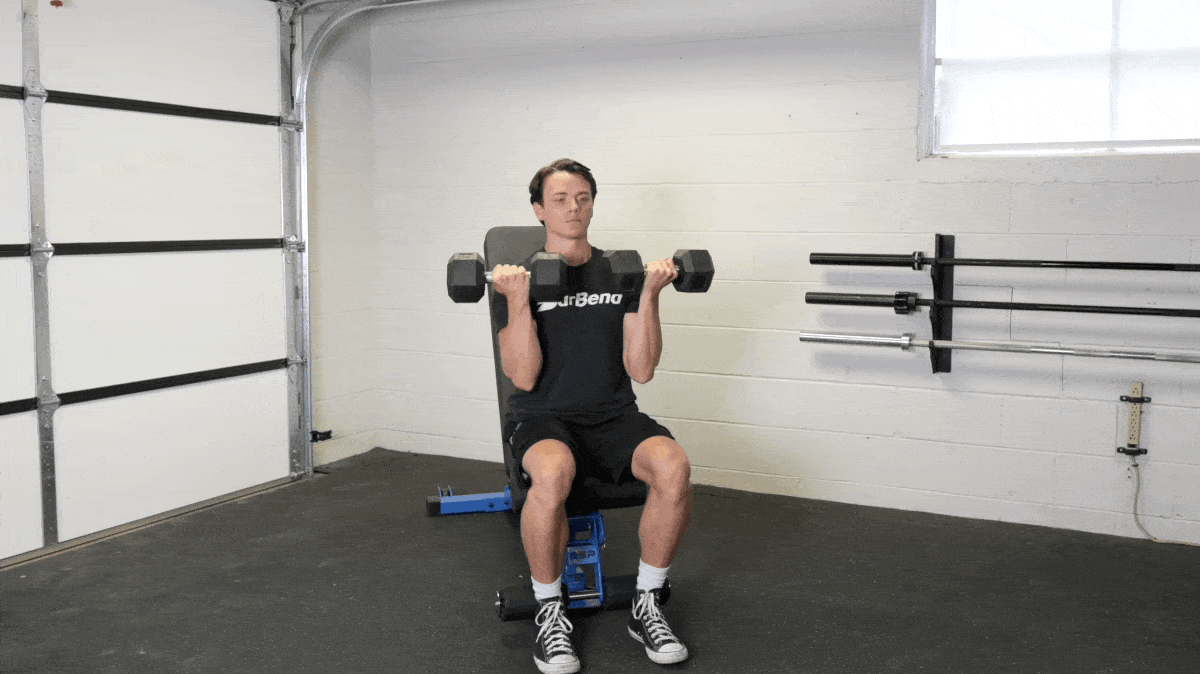
[Read More: The Best Shoulder Exercises for Building Muscle]
| Equipment Needed | Adjustable bench or seat, dumbbells, wrist wraps (optional) |
| Muscles Worked | Shoulders, triceps, serratus anterior |
| Sets & Reps | 3 x 8-12 |
Named after bodybuilding legend himself Arnold Schwarzenegger, this dumbbell shoulder exercise is tailored perfectly for engaging all three sections of your delts. Moreover, the Arnold press is a pressing variation you flat-out can’t perform with a barbell, so we think it deserves some points for novelty.
How To Do It
- Sit upright in a seat or bench with a pair of dumbbells in each hand.
- Your arms should be bent with the weights held in front of your face, palms facing you.
- Rotate your arms outward and up, pressing your arms overhead.
- Reverse the motion, rotating your arms back into the starting position to complete the rep.
13. Renegade Row
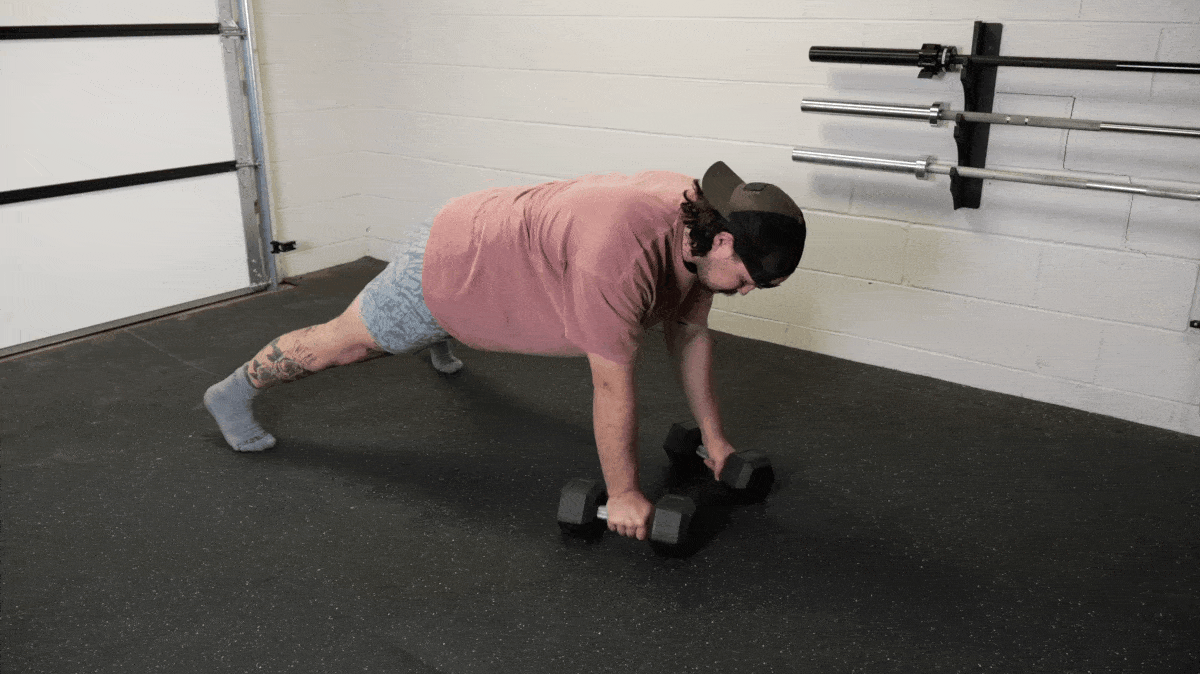
| Equipment Needed | Dumbbells, exercise mat (optional) |
| Muscles Worked | Core, lats, shoulders |
| Sets & Reps | 3 x 15-20 |
Combining your upper body work with some core training is wise if you’re trying to shave time off your workout routine. Luckily, you can utilize dumbbells to build up your lats and forge an ironclad set of abs at the same time with the renegade row.
How To Do It
- Assume a standard push-up position, but instead of your palms pressed against the floor, they should be gripping a pair of dumbbells that are resting on the floor.
- Alternate your arms as you row one dumbbell up to your trunk while keeping the other arm straight.
Modifications
- Make It Easier: You can do renegade rows from a kneeling position if you aren’t ready to support yourself in a full plank just yet.
- Make It Harder: Pause at the top of each rep, holding your upper arm snugly to your torso for a few seconds.
14. Lateral Raise
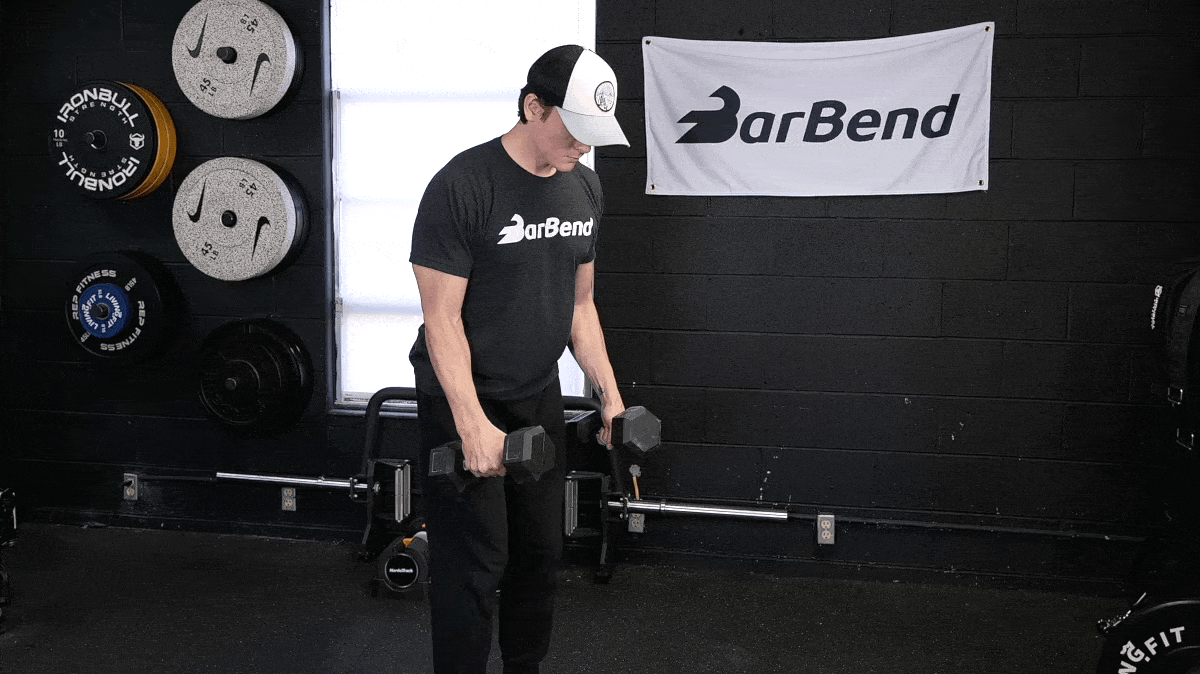
| Equipment Needed | Dumbbells |
| Muscles Worked | Lateral deltoids |
| Sets & Reps | 2-3 x 12-20 |
For healthy, functional, and aesthetic shoulders, you need to train all three of the deltoid’s heads. To hit the middle, or lateral, aspect of your shoulder, you have to perform the lateral raise. It’s the only practical way. What piece of equipment is ideally suited for the lateral raise? A pair of dumbbells.
How To Do It
- Stand upright with a pair of dumbbells in each hand down at your sides.
- From here, slowly raise your arms outward and upward until they’re roughly parallel with the floor, palms pointing down.
Modifications
- Make It Easier: Bend your elbows to 90 degrees to reduce the tension on your shoulder joints.
- Make It Harder: Set an adjustable bench to a nearly-upright position and lean against it. This will remove your ability to use momentum during the exercise.
3 Dumbbell Workouts To Try
Want to put these moves into action? We’ve got you covered. Designing dumbbell workouts for muscle growth, strength, or any other fitness goal isn’t easy, so we’re taking the guesswork out of the equation. Here are a few of our favorite dumbbell-based workout routines:
Warm-Up
First things first, you’ll need to warm up, no matter what sort of workout you’re doing. 5 to 10 minutes of easy cardio exercise will get your blood pumping, so start there. Afterward, be sure to perform at least one ramp-up set before doing any dumbbell compound exercises.
Upper-Body Dumbbell Workout
Dumbbells let you work your arms or legs unilaterally, which ensures that your muscles grow at the same rate, without one side picking up slack for the other. Try this upper-body dumbbell workout to increase hypertrophy and build new muscle mass:
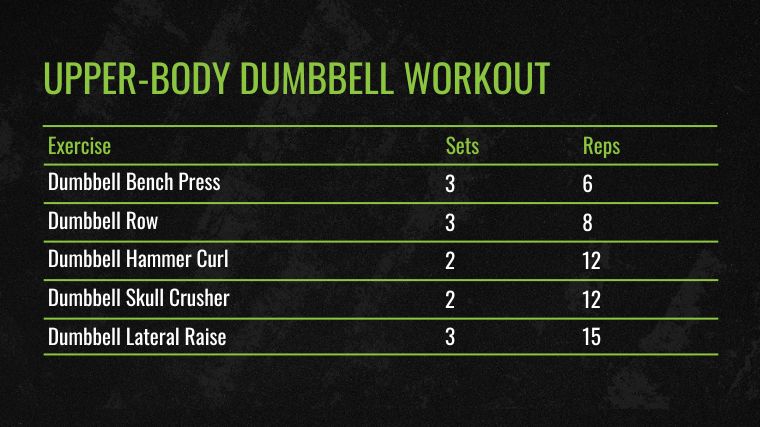
- Dumbbell Bench Press: 3 x 6
- Dumbbell Row: 3 x 8
- Dumbbell Hammer Curl: 2 x 12
- Dumbbell Skull Crusher: 2 x 12
- Dumbbell Lateral Raise: 3 x 15
Dumbbell Leg Workout
Want to work your legs? You don’t have to do barbell squats. As long as you have access to some decently-heavy dumbbells, rest assured that you can train your legs without needing to head to the squat rack.

- Goblet Squat: 3 x 10
- Dumbbell Romanian Deadlift: 3 x 10
- Dumbbell Lunge: 2 x 12
- Standing Dumbbell Calf Raise: 2 x 20
Home Dumbbell Workout
If you want to workout at home but only have one pair of dumbbells, don’t worry. We have a workout for you. This workout is designed to be performed as a circuit; do these moves back-to-back with little to no rest in-between.
Note: This workout is designed to be performed with a pair of 15-to-35-pound weights. If you have a heavier pair, consider changing up the rep ranges as needed.
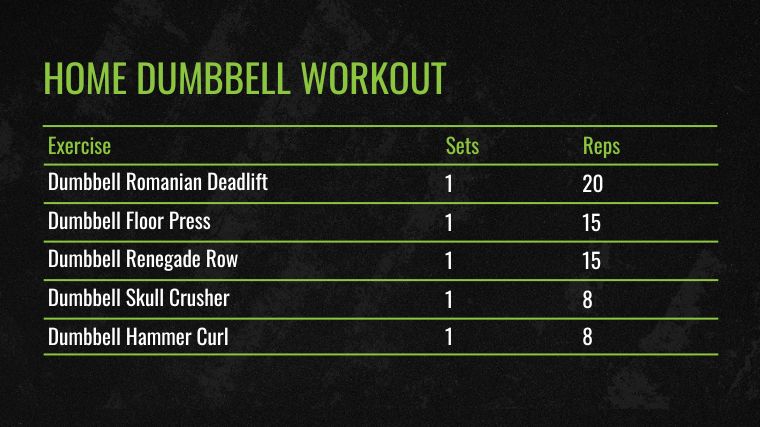
- Dumbbell Romanian Deadlift: 20 reps
- Dumbbell Floor Press: 15 reps
- Dumbbell Renegade Row: 15 reps
- Dumbbell Skull Crusher: 8 reps
- Dumbbell Hammer Curl: 8 reps
Benefits of Dumbbell Training
Dumbbells are for everyone — first-time gymgoer and professional athlete alike. If you’re wondering why they’re so widely used in the fitness industry, rest assured that they’re far from a fad.
They aren’t the be-all, end-all of exercise equipment, but working with dumbbells provides more than a few unique benefits that you should be mindful of.
Corrects Muscle Imbalances
By their very nature, dumbbells allow you to work each of your arms or legs independently — as well as the corresponding muscles that move those joints.
[Read More: The Best Online Workout Programs For Coaching, Cardio, Value, And More]
This allows you to identify, attack, and remedy any imbalances or side-to-side weaknesses you may have. While a barbell or fixed-path machine can sometimes mask these issues (since you’re moving a single piece of resistance with both your arms, for example), dumbbells will quickly show you where your weak spots are so you can take the right actions against them.
Targets Weak Points
As the dumbbell is a single-side implement, you can think of it as more of a scalpel than a hammer. Barbell exercises are wonderful for stimulating a lot of muscles quickly and with high loads.
However, barbells can’t hold a candle to the precise stimulation and resistance offered by a dumbbell. You’d find it difficult, for instance, to properly target your side delts with another type of free weight.
Independent Movement
When working with adjustable dumbbells, your limbs have more freedom and less restriction than if you used another implement. This can be particularly helpful when performing exercises such as the bench press, where your individual anatomy strongly impacts your form.
No one is perfectly symmetrical side-to-side; dumbbells allow your body to move as it was designed to, rather than having to adhere to a rigid or cumbersome path.
Teaches Motor Control
Single-arm (or leg) exercises do a lot more for your body than just stimulating the muscle or muscles in question.
When you load one limb at a time, your body still has to stabilize and control the transfer of force between the weight itself and the surface you’re in contact with. In practical terms, this means that a single-arm press will tax your core as it attempts to stabilize your spine, providing some “bonus” ab training.
This principle holds true for any movement you opt to perform with, or on, one limb.
Builds Plenty of Strength
If your priority is maximal strength above all else and at any cost, you should probably spend a lot of time with the barbell — especially if you’re aspiring toward a strength sport like powerlifting.
Barring that, you shouldn’t forsake dumbbells in your pursuit of getting stronger in general. They’ll work just fine for strength, even if you aren’t lifting comparably heavy weights as you would in a similar barbell-based movement. (1)
Use Dumbbells to Lift Well
The equipment you use in the gym is less important than the sets and reps you select, which are less important than having motivation to be consistent in the first place.
That said, the devil is in the details when it comes to maximizing your fitness potential. Dumbbells shouldn’t make up your entire routine (though they certainly can) at all times, but they’re versatile, customizable, and easy to use.
Frequently Asked Questions
Can you train your whole body with just dumbbells?
Yes! Dumbbells are incredibly versatile. With the right exercises in your arsenal, you can train your back, chest, arms, core, or legs.
What are the best dumbbell exercises for beginners?
Dumbbells are great for beginners because they train your muscles and teach you how to stabilize your body while you work out. For beginners, we recommend moves like the dumbbell row, bench press, shoulder press, lunge, and Romanian deadlift.
Are 20lb dumbbells enough to gain muscle?
It depends. Strength is relative; 20 pounds may be quite heavy for you, but too easy for your gym partner. Compound exercises that involve motion at more than one joint will also allow you to lift more than 20 pounds eventually. That said, a pair of 20-pound dumbbells will remain useful on isolation moves like the lateral raise, skull crusher, or hammer curl for quite a while.
References
- Heinecke, M. L., Mauldin, M. L., Hunter, M. L., Mann, J. B., & Mayhew, J. L. (2021). Relationship of Barbell and Dumbbell Repetitions With One Repetition Maximum Bench Press in College Football Players. Journal of strength and conditioning research, 35(Suppl 1), S66–S71.
link







